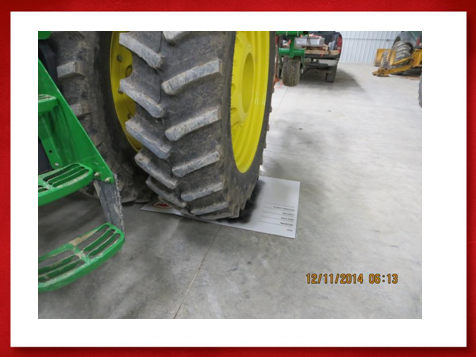October 31, 2016

As harvest nears completion in some areas, attentions are turning quickly to field conditioning. The experts from Firestone Ag share top tire tips to get the most out of your tractor.
 Maintaining proper tire inflation pressure plays a vital role in tire and equipment performance and can impact traction in the field. “Using a higher inflation pressure causes the tire’s footprint to be smaller, which results in slippage and reduced efficiencies,” explains Brad Harris, field engineer, Firestone Ag. “Lower inflation pressure can lead to deflection, and this can damage the tire’s sidewall over time.”
Maintaining proper tire inflation pressure plays a vital role in tire and equipment performance and can impact traction in the field. “Using a higher inflation pressure causes the tire’s footprint to be smaller, which results in slippage and reduced efficiencies,” explains Brad Harris, field engineer, Firestone Ag. “Lower inflation pressure can lead to deflection, and this can damage the tire’s sidewall over time.”
To accurately determine proper tire inflation pressure, the axle load must be considered.

If pull-type equipment is used, the tractor can be weighed and pressure calculated. If three-point mounted equipment is used, the tractor should be weighed with the tillage tool attached.
 Once the equipment weights are determined, the tire size, axle weights and vehicle configurations can be entered into Firestone’s tire inflation pressure calculator to determine proper inflation pressure.
Once the equipment weights are determined, the tire size, axle weights and vehicle configurations can be entered into Firestone’s tire inflation pressure calculator to determine proper inflation pressure.
Soil moisture can also impact equipment performance. If soil conditions are dry and causing power hop while deep ripping or chisel plowing, Harris has some insights on how to reduce it.
“First, make sure the weight split on the tractor is correct, and that the inflation pressures have been set based on axle load,” says Harris. “If power hop continues, increase the inflation pressure on one axle. For mechanical front wheel drive tractors, increase the inflation pressure 6 psi on the front axle. For four wheel drive tractors, increase the inflation pressure 6 psi on the rear axle. When moisture returns to the soil after it rains, the inflation pressure can be set back down.”
“Unfortunately, corn stubble is harder than the rubber on a tire,” continues Harris. “We recommend driving in between the rows, or using stalk stompers that can push over the corn stalks. With a little insight and care, you can rely on your tires to pull you through years of tough farming conditions.”
**This article is provided by Firestone Tires as an educational article.**
You May Also Like




